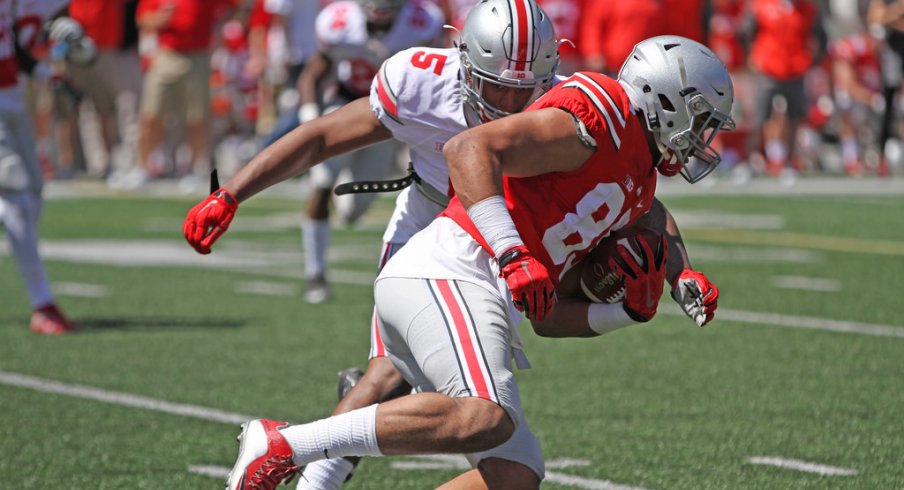ScriptOhio
Everybody is somebody else's weirdo.
A Pair and a Spare No Longer Enough at Quarterback
Roster management is a little talked-about but important aspect of coaching in today's college football environment, and through the years it's gotten to be a tougher proposition.
When Woody Hayes was around at Ohio State the NCAA roster limit was 120 scholarship players. That meant you could have a lot of talented backups on the roster that you were grooming to be contributors as upperclassmen. By the time John Cooper arrived at OSU the scholarship limit had been reduced to 95, and having adequate depth was getting tough. When Coop left, the limit was down to the 85 that is the current roster scholarship limit.
The shrinking roster has made roster management essential and more difficult. How many scholarships do you allocate to offense, how many to defense, how many for offensive linemen, how many for linebackers?
The common wisdom for a long time was the "pair and a spare" concept. You needed three guards you could count on, three tackles, etc. It was a decent guideline, but a team could end up thin at a position if it got hit by multiple injuries, transfers or academic casualties at a given single position. The Buckeyes saw a bit of that at the linebacker position a few years ago.
Amazingly, a position at which coaches have tended to be a little miserly with scholarship is the most important position on the team, quarterback.
Until recently it was rare for a team to have more than three scholarship quarterbacks on the roster, two of which were ready to play and could be counted on. That left you with a little more room for linemen or running backs or any other position, but was a fairly high-risk strategy because a team with a bad quarterback is more than likely a bad team. You need to think back no further than the Jim Tressel era at Ohio State for an example of that.
Tressel had some very effective quarterbacks, but he rarely had a lot of them on the roster at any one time. That turned out to be a very bad thing in 2011 when Terrelle Pryor was suddenly no longer on the roster and the Buckeyes were down to three scholarship quarterbacks, Joe Bauserman, Kenny Guiton and true freshman Braxton Miller. You probably don't need to be reminded how that came out.

Urban Meyer does not want that to happen again.
Meyer was asked recently if he prefers at least four quarterbacks on his roster. His response was immediate and definitive. He wants four, and was quick to point out that it was recent history at Ohio State that has changed attitudes toward quarterback numbers not just in Columbus, but across the country.
"I think everybody does. It’s not us guys, it’s college football," said Meyer.
"Everybody learned a big-time lesson a couple years ago when Ohio State won the national title with the No. 3 signal caller."
Entire article: http://theozone.net/Ohio-State/Football/2016/News/A-Pair-and-a-Spare-No-Longer-Enough-at-Quarterback
Roster management is a little talked-about but important aspect of coaching in today's college football environment, and through the years it's gotten to be a tougher proposition.
When Woody Hayes was around at Ohio State the NCAA roster limit was 120 scholarship players. That meant you could have a lot of talented backups on the roster that you were grooming to be contributors as upperclassmen. By the time John Cooper arrived at OSU the scholarship limit had been reduced to 95, and having adequate depth was getting tough. When Coop left, the limit was down to the 85 that is the current roster scholarship limit.
The shrinking roster has made roster management essential and more difficult. How many scholarships do you allocate to offense, how many to defense, how many for offensive linemen, how many for linebackers?
The common wisdom for a long time was the "pair and a spare" concept. You needed three guards you could count on, three tackles, etc. It was a decent guideline, but a team could end up thin at a position if it got hit by multiple injuries, transfers or academic casualties at a given single position. The Buckeyes saw a bit of that at the linebacker position a few years ago.
Amazingly, a position at which coaches have tended to be a little miserly with scholarship is the most important position on the team, quarterback.
Until recently it was rare for a team to have more than three scholarship quarterbacks on the roster, two of which were ready to play and could be counted on. That left you with a little more room for linemen or running backs or any other position, but was a fairly high-risk strategy because a team with a bad quarterback is more than likely a bad team. You need to think back no further than the Jim Tressel era at Ohio State for an example of that.
Tressel had some very effective quarterbacks, but he rarely had a lot of them on the roster at any one time. That turned out to be a very bad thing in 2011 when Terrelle Pryor was suddenly no longer on the roster and the Buckeyes were down to three scholarship quarterbacks, Joe Bauserman, Kenny Guiton and true freshman Braxton Miller. You probably don't need to be reminded how that came out.

Urban Meyer does not want that to happen again.
Meyer was asked recently if he prefers at least four quarterbacks on his roster. His response was immediate and definitive. He wants four, and was quick to point out that it was recent history at Ohio State that has changed attitudes toward quarterback numbers not just in Columbus, but across the country.
"I think everybody does. It’s not us guys, it’s college football," said Meyer.
"Everybody learned a big-time lesson a couple years ago when Ohio State won the national title with the No. 3 signal caller."
Entire article: http://theozone.net/Ohio-State/Football/2016/News/A-Pair-and-a-Spare-No-Longer-Enough-at-Quarterback
Upvote
0















